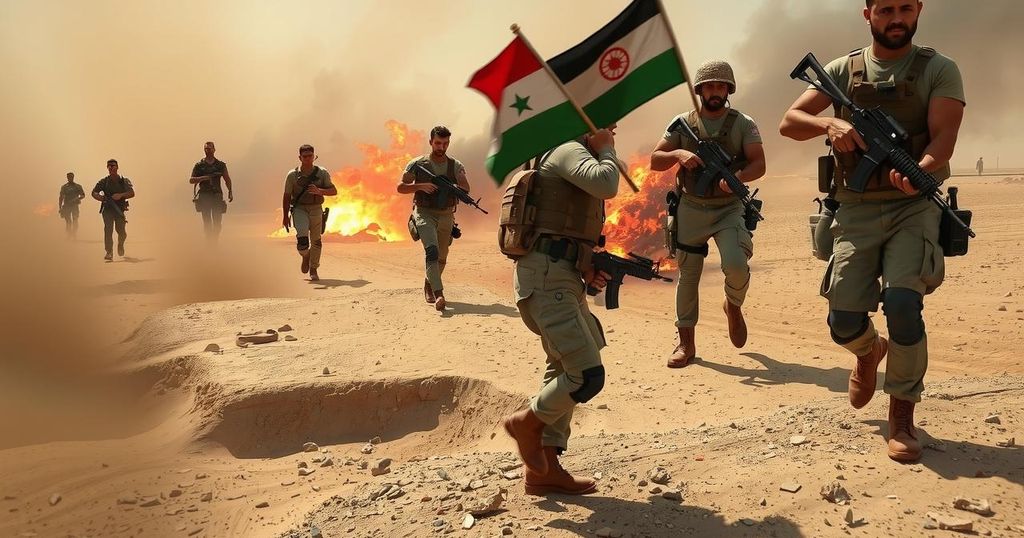The Resurgence of Conflict in Syria: Analyzing the Escalation and Its Implications

The conflict in Syria has reignited amid regional turmoil, with Bashar al-Assad’s regime facing a significant offensive by rebel groups led by Hayat Tahrir al-Sham. Recent territorial gains by the rebels signal an escalation of hostilities, yet Assad’s regime retains considerable backing from certain factions. International concerns are rising regarding the humanitarian implications and the ongoing political stalemate in efforts to resolve the conflict.
The recent surge in the conflict within Syria operates amidst the backdrop of ongoing turmoil in the Middle East, a situation exacerbated by the Hamas attacks on Israel on October 7 last year. As the war reignites, it becomes evident that the situation is intensifying rather than calming. Bashar al-Assad’s regime has proven resilient over the past decade, primarily due to its alliances with powerful actors such as Russia, Iran, and Hezbollah, who intervened on its behalf against various rebel factions.
However, recent developments have significantly altered the dynamics of the conflict. Iran, negatively impacted by Israeli airstrikes, has seen its ally Hezbollah weakened, while Russia’s military focus on Ukraine limits its engagement in Syria. Even as the international spotlight has shifted away from Syria due to broader regional conflicts and access restrictions for media personnel, the war remains unresolved, with ongoing power struggles.
Assad’s regime has not fully reclaimed its pre-2011 authority, although it maintained control over significant urban areas and critical supply routes until recently. Notably, a coalition of rebel groups, led by Hayat Tahrir al-Sham (HTS), has launched an extraordinary offensive, capturing territory and effectively routing government forces in a matter of days. Remarkably, they have reclaimed the ancient citadel of Aleppo, an important stronghold that had been under government control for years.
The HTS, despite its roots in al-Qaeda, is attempting to rebrand itself to broaden its appeal among the Syrian populace, promoting its current offensive as a collective resistance rather than a strictly jihadist agenda. Such terminology has been used strategically to avoid alienating moderate Syrians who harbor a deep-seated wariness towards extremist ideologies.
The political landscape in northern Syria is fragmented, with various groups including the Syrian Democratic Forces (SDF) controlling certain areas. Recent reports suggest that rebel forces are advancing rapidly, likely fueled by substantial military supplies and equipment acquisitions. Furthermore, the Assad regime’s reliance on air strikes as a countermeasure will be imperative in the face of these aggressive maneuvers by the rebels.
The renewed hostilities have prompted international concern, with calls from UN envoy Geir Pedersen highlighting the risks posed to civilians and the broader implications for regional stability. Pedersen emphasized a collective failure to initiate a political resolution that adheres to UN Security Council resolution 2254, which outlines a pathway for a peaceful Syria governed by the will of its people.
Despite the recent successes of the rebels, it remains premature to dismiss the Assad regime entirely. A contingent of support persists for Assad among Syrians, who perceive the regime as a lesser evil when juxtaposed with more extremist factions. Nevertheless, should other anti-Assad forces capitalize on the current environment of unrest, the regime may once again encounter life-threatening challenges.
The conflict in Syria has persisted since 2011, characterized by civil unrest that escalated into a brutal war. President Bashar al-Assad’s regime initially faced significant threats from various rebel groups, including extremist factions. Throughout the chaos, Assad maintained control with the assistance of allies—most notably Russia, Iran, and Hezbollah—while navigating a complex political and military landscape. The resurgence of hostility in Syria closely ties to shifts in regional power dynamics, particularly following the new Israeli-Hamas conflict, which has ramifications for Iran and Hezbollah’s capacities to support the Assad regime.
The ongoing conflict in Syria points to a complex and evolving situation marked by renewed hostilities among rebel factions and the Assad regime. With crucial military support shifting and new offensives taking place, the landscape may shift significantly. Nevertheless, it is crucial to recognize that Assad’s regime retains a core group of support and should not be underestimated, especially in light of the diverse elements within the Syrian opposition. The international community’s response and potential interventions will play a pivotal role in shaping the future of Syria in these tumultuous times.
Original Source: www.bbc.co.uk






